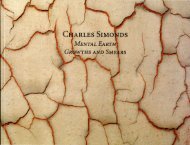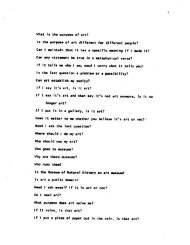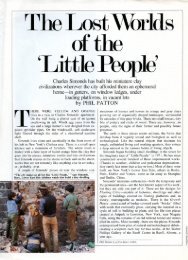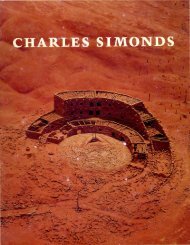manmade emerging
Reynolds "Dwelling as a World" - Charles Simonds
Reynolds "Dwelling as a World" - Charles Simonds
You also want an ePaper? Increase the reach of your titles
YUMPU automatically turns print PDFs into web optimized ePapers that Google loves.
Dwelling as a WorldAnn ReynoldsThe significance of cultural behaviour is not exhausted when we have clearly understood that it is local and <strong>manmade</strong>and hugely variable. It tends also to be integrated. A culture, like an individual, is a more or less consistentpattern of thought and action. The form that these acts take we can understand only by understanding first theemotional and intellectual mainsprings of that society.Ruth Benedict, Patterns of Culture1Charles Simonds builds little worlds out of clay and other malleable materials. These worlds consist of carefullydetailed miniature buildings or more elaborate, often quite fantastical, architectural and landscape environments. Healso creates rather unconventional self- portraits by manipulating his facial features into more generalized orgrotesque masks. Scattered throughout the indoor and outdoor spaces and amid the different collections at theDumbarton Oaks Museum and Gardens during his exhibition Landscape Body Dwelling, these miniature worlds andportrait heads slipped into their chosen surroundings, becom- ing almost at home there. In some instances, individualworks were so compatible with their environments as to be initially difficult to discern; in others, an initial surpriseencounterled to a deeper appreciation of the preexisting formal, aesthetic, emotional, or pedagogical terms of a work’ssurroundings. Mental Earth, a large landscape of twisted rock formations punctuated with small, intricate dwellings,was suspended from the center of the ceiling of the Orangery, filling this space and echoing the large, creeping figvine that extends up and along all sides of the room. A long staff with the distorted image of the artist’s head <strong>emerging</strong>from one end lay on the grass within an elegant terrace complete with two shallow,|67cartouche-shaped pools. The fountains in these pools, which consist of a single putto embracing a large fishthat spews a thin, steady, vertical stream of water, provided a humor- ous contrast to the menacing figure <strong>emerging</strong>from the horizontal staff (top left). Installed among the collections in the museum galleries, Simonds’s clay Pyramidand Rock Flower sug- gested didactic models of the hypothetical dwellings of the peoples whose cultural objectssurrounded these miniature structures. His Y, a crossing of two long, three-dimensional, amoebalike forms whosesurfaces are covered with tiny gray bricks studded with spiky or pimply orange protrusions, bore no immediate formalresemblance to the objects surround- ing it in the Byzantine gallery, but its anthropomorphic visceralnessnevertheless echoed the stark religiosity and faith in the transubstantiation of the flesh that many of the Byzantineobjects on display were originally made to serve.What Simonds refers to as his “cabinet of curiosities” appropriately occupied a space adjacent to the Rare BookRoom (bottom left). This collection of small objects, images, and texts from a wide variety of time periods, some madeby the artist and oth- ers photocopied from books and magazines, provided a specific set of historical and visualprecedents for Simonds’s work and, at the same time, demonstrated that his imagery and central concerns are partof a historically and culturally broad yet finite set of visual arche- types or perhaps, to use George Kubler’sterminology, part of the replica-mass of a limited set of panhistorical prime objects. Kubler’s prime objects consist ofthe singular, key monu- ments in the history of art, such as Stonehenge, the Parthenon, and the portal statues atReims Cathedral. Few remain in completely manifest form, and most are known only through countless copies, whatKubler calls the replica-mass of each prime—“the entire system of replicas, reproductions, copies, reductions,transfers, and derivations floating in the wake of an important work of art.”2 Some replicas in this mass reproduce theprime completely, while others alter it slightly so that, in time, what Kubler refers to as the replica’s “drift” from theprime is recognized by a particularly perceptive artist, who then imposes a new scheme on the mass of replicas thatmore directly corresponds to its current historical moment and circumstances.3 Simonds engages with his chosenprimes and their trailing replica-mass in such a manner by extending their legacy and subsequently shaping it toaccommodate new historical circumstances and exhibition contexts.Throughout his installation, Simonds highlighted the central terms of his art— landscape, body, and dwelling—bycalling attention to overarching patterns of shared motifs and ideas through subtle associations and contrastsbetween his objects and the objects and environments surrounding them. As a result, Simonds’s works in thisexhibition68|Ann Reynoldsnot only literally represent miniature worlds but also function as dynamic visual, concep- tual, and emotional catalystsfor imagining many different worlds simultaneously within the preexisting contexts—natural and man-made, historicaland geographical— at Dumbarton Oaks.Imaginative world-making has been central to Simonds’s practice from the very beginning, but his dwellings for theLittle People, which he began to make in the early 1970s in New York and continues to make whenever he travels toa new city, are emblem- atic of this process and provide many of the foundational terms for his art and his ongoingapproach to exhibition design, as demonstrated at Dumbarton Oaks. Although the urban situations for his earlydwellings couldn’t be more different than the exhibition spaces at Dumbarton Oaks, a consideration of thesedwellings, several films that were made about them, and aspects of the larger historical context for both illuminatesthe fundamental terms of Simonds’s ongoing commitment to creating worlds that are simultaneously imagi- nary orutopian and real, materially present and yet physically highly unstable, miniature and life size, timeless and timely.Around 1970, Simonds began making miniature clay dwellings on Greene Street below Houston in New York. At thetime, he was sharing a large loft space on Christie Street with Gordon Matta-Clark, not far from Greene Street. His
initial motivation was to make a home, to feel at home in a city that was, in fact, his hometown—he was born inManhattan in 1945—but yet in which he felt like a migratory orphan.4 He created these dwellings for himself but alsofor a fantasy community that he called the Little People. At the time, he conceived of these Little People as dividedinto two groups: the Plains People, the farmers and shepherds who lived at street level in potholes and along curbs(right); and the Cliff-Dwellers, the hunters and nomads who made their homes on the window ledges of the buildingsfacing the street.5 For each group, Simonds constructed environments that included dwellings made out of tiny claybricks loosely modeled on ancient architectural forms, including early Native American cliff dwellings. In all cases,these dwellings appeared to be abandoned or falling into ruin. The two tribes, according to the scenario Simondsdeveloped for them, were culturally polar opposites, and thus con- stantly at war with one another. But the biggerenemies they both faced were the weather, since the unfired clay bricks out of which their dwellings were mademelted in rain or snow, and the passers-by, who either inadvertently destroyed their dwellings, by stepping on themor trying to dislodge them from their surroundings in order to take them home, or willfully destroyed them by throwingstones at them.Dwelling as a World |69In the early 1970s, artists had already begun to occupy and refurbish portions of the increasing number of emptywarehouses and commercial buildings that filled the area between Houston Street and Canal Street west ofBroadway. This part of town was not yet the SoHo dominated by commercial art galleries, shops, and restaurantsthat it came to be by the late 1970s and early 1980s, but it was already an area in transition. Due to its transitorystatus, the streets were primarily occupied by two distinct groups of people: the increasing numbers of artists wholived there, and the workers and truckers who didn’t live there but who were in and out of the area daily, delivering,manufacturing, or pick- ing up goods at the buildings that were still in commercial use. According to Simonds, theartists, his own peers, had little to no interest in what he was doing, and, in some cases, were contemptuous of hisactivities. But the truckers and workers quickly and enthusiasti- cally engaged him in conversation, took up his storiesabout the Little People as a matter of course, and began to look for him and his dwellings when they were in thearea. This disparity in responses prompted Simonds to look for a neighborhood in which the residents might be moreopen and willing to engage with him and his Little People. And once he found it in the far East Village, between 14thStreet and Houston and Avenues A and D, he traveled there every day on his three-wheeled delivery bicycle filledwith supplies, selected sites, and made his dwellings, like an itinerant laborer (left and facing page).His chosen neighborhood was occupied primarily by Caribbean immigrants and their children. They lived amid thrivingdrug trafficking and an urban landscape that con- sisted of twenty to thirty percent vacant lots or buildings. Most ofthese vacant buildings were in receivership due to deliberate neglect by their landlords and by the city—the hopebeing that the city could then reclaim entire blocks for urban renewal at some unspecified future date. The early1970s was a low point financially for New York, and many sections of the city, especially downtown and uptownabove 96th Street, looked the way the Lower East Side did. But the community Simonds entered was trying to dosomething about the gradual ceding of their neighborhood to the ruin the city deemed a necessary preliminary to itsown appropriation, even if the neighborhood’s efforts to claim small portions of space for parks, community centers,and housing were only temporary footholds. The constant refrain of neighborhood activists, “every time we dosomething, it gets broke,” was emblematic of the situation.6 It is significant to note that such local groups were oftenreferred to as the “little people” in newspaper accounts concerning proposed urban renewal plans for the city, andthat these groups sometimes even referred to themselves in this way, if only in an attempt at subversive irony.70|Ann ReynoldsFrom the late 1960s into the mid-1970s, conversations about the role of public sculpture within urban developmenthad become quite heated, both as a result of sev- eral contemporary exhibitions, including Sculpture in Environmentin New York in 1967, and because of an increasing number of public commissions tied to new building projects invarious parts of the city. What is, perhaps, most remarkable about these conversations from the perspective of thepresent is the fact that no one writing about the sculpture in these exhibitions and/or works commissioned for publicspaces assumed that these works should incorporate references to the specific formal, social, or historicalcircumstances of the sites they occupied into their design. At a moment when the unpredictable dynamics of urbanrenewal often dictated the terms, an artist’s acknowledgment of site meant creat- ing a sculpture that was eitherphysically expendable or could be moved to another site. In her review of Sculpture in Environment, the art critic andcurator Lucy Lippard described the situation: “Most of New York’s neighborhoods are temporary. We could capitalizeon the city’s impermanent quality instead of sitting back and deploring it. With buildings cavalierly thrown up andmown down, permanent sculpture is often irrelevant. Good sculpture does not automatically become obsolete, but ifits setting is changed, it may become unsuit- able.”7 Urban renewal created new opportunities for public sculpture,but, at the same time, it could render an individual work unsuitable for its site, allowing it to be removed or evendeliberately destroyed. The precarious, eclectic, and ever-changing nature of the urban environment was thusmirrored in public sculpture’s presumably tenuous existence. Both were necessarily impermanent and open totransformation.In the face of demands for sculptural impermanence and the concomitant spatially and temporally disorienting urbanexperiences produced by the fluctuating juxtapositions of old buildings, new buildings, and empty lots, a number ofartists made what were referred to at the time as “anti-monuments.” Barnett Newman’s Broken Obelisk and ClaesOldenburg’s Placid Civic Monument, works completed in 1967 and included in Sculpture in Environment, exemplifytwo general types: an inverted romantic ruin, in the case of Broken Obelisk, and a negative and ultimately invisible
monument, in the case of Placid Civic Monument. For the latter, Oldenburg hired professional grave-diggers to digand then fill a six-foot-deep rectangular hole behind the Metropolitan Museum of Art. A few photographs of the workers’efforts exist, but the location was not marked and eventually grass grew over the spot, erasing any physicalevidence of the work’s existence.8 By calling a highway construction site in Passaic, New Jersey, a “ruin in reverse,”Robert Smithson insisted that urban renewal could also be viewed as a form of time-travel: “That zero panoramaseemed to contain, that is—allDwelling as a World |71the new construction that would eventually be built. This is the opposite of the ‘romantic ruin’ because the buildingsdon’t fall into ruin after they are built but rather rise into ruin before they are built. This anti-romantic mise-en-scenesuggests the discredited idea of time and many other ‘out of date’ things.”9Because of their small scale, precarious locations, and material fragility, Simonds’s dwellings for the Little Peoplecould be viewed as a type of anti-monument or, because of the way they were constructed, ruins in reverse (top left).And his sculptural interventions were directed at many of the same social, cultural, and material circumstances andeffects of urban renewal that Oldenburg, Smithson, and others were engaging. However, Simonds’s goal was quitedifferent.10 In addition to reiterating or commenting on the urban situation on a miniature scale, he offered a life-sizealternative that was directed to local communi- ties and not primarily to other members of the art world. In his words,he sought “to make a mythology that existed in real time and space, which members of the community could chooseto invest in and make part of their day to day in whatever way they would like.”11 Simonds also invested in the realitiesof this community by joining their political fights, applying his ideas to more practical built solutions, and inspiringcollaboration. Through their gatherings around his dwellings, for example, some residents of one block got the ideato transform a vacant lot adjacent to a Little People dwelling into a playground, which Simonds helped them designand called La Placita. As a member of the Lower East Side Coalition for Human Housing, Simonds also helped thecommunity to activate the existing local channels to get permission and some financial support from the city toexecute this project. At the same time, he created several fantasy park models for the same space (bottom left).“Dwelling,” a word that can function as a noun and as a verb, reflects Simonds’s dual engagement with his chosencommunity on the Lower East Side. A dwelling can be a physical space in which to live or a description of thetemporal experience of dwelling—both can be imagined or real. Simonds describes: “When I’m working I never seeLittle People. I am not insane. But I do think about them. What are they doing in that corner? It’s a place you let yourmind relax into . . . I don’t think about the Little People. I think about me in there. It’s a mental positioning inside. ButI also think of them—they’re incorporeal, but they’re quite alive.”12 And, for Simonds, these modes of spatial andtemporal, corporeal and mental dwelling that one can relax into define a particular kind of social interaction and rolefor him as an artist, one associated with a set of responsibilities rare in twentieth-century urban environments, butquite common in earlier cultures, particularly those possessing vital, communal traditions. Simonds states: “Thepeople on the Lower East Side see me as a kind72|Ann Reynoldsof folk figure who comes and delivers the Little People. It’s not like I’m making things. It’s like I’m the carrier, theharbinger. Conceptually, as well as physically, the dwellings fall apart when thought of as objects that can be takenhome. They lose all their spatial and temporal expansiveness.”13Simonds has also described the dwellings as “the medium through which we talk,” and a series of short films made bySimonds and Rudy Burckhardt from 1972–74 elucidates through sound and image how this worked as a form ofstorytelling.14 In these films, the people who gather around Simonds while he is making the dwellings express most ofthe artist’s ideas; they become participant-observers in the process by telling the story of the Little People to eachother, sometimes becoming the spokespersons for them or for the artist, whereas Simonds is mostly silent or evenabsent. I think this is a deliberate decision on the part of the filmmaker and the artist, even though, in reality,Simonds directly engaged with his audience while working (right). Because Simonds’s voice is absent from the collectiveconversations in these films, the viewer becomes more aware of the basic ideas and information concerning theLittle People as a story that is being told and retold in slightly different ways, even though it is clear that theexperience and its perimeters are mutually acknowledged by all of the participants.In his 1936 essay “The Storyteller,” the German cultural critic Walter Benjamin describes the storyteller as ahistorically situated figure from the past, one who was able, along with the community he served, to exchangeexperiences and provide social counsel. Whereas increasingly, Benjamin claims, experience itself “has fallen in value”because it is no longer collectively shared:Experience which is passed on from mouth to mouth is the source from which all storytellers have drawn . . . thereare two groups which, to be sure, overlap in many ways. And the figure of the storyteller gets its full corporeality onlyfor the one who can picture them both. “When someone goes on a trip, he has some- thing to tell about,” goes theGerman saying, and people imagine the storyteller as someone who has come from afar. But they enjoy no lesslistening to the man who has stayed at home, making an honest living, and who knows the local tales and traditions.If one wants to picture these two groups through their archaic repre- sentatives, one is embodied in the resident tillerof the soil, and the other in the trading seaman. Indeed, each sphere of life has, as it were, produced its own tribe ofstorytellers. Each of these tribes preserves some of its characteristics centuriesDwelling as a World |73later. The actual extension of the realm of storytelling in its full historical breadth is inconceivable without the mostintimate interpenetration of these two archaic types. Such an interpenetration was achieved particularly in the Middle
Ages in their trade structure. The resident master craftsman and traveling journeymen worked together in the samerooms; and every master had been a traveling jour- neyman before he settled down in his home town or somewhereelse. If peasants and seamen were past masters of storytelling, the artisan class was its university. In it wascombined the lore of faraway places, such as a much-traveled man brings home, with the lore of the past, as it bestreveals itself to natives of a place.15Through the two archaic types of the seaman and the peasant farmer, the resident craftsman and the travelingjourneyman, home and away are combined. This is reflected in Simonds’s sense of himself as a native New Yorkerand as an orphan, an itinerant carrier or harbinger. He comes from somewhere else, but becomes a committedmember of the community through his daily presence and his eventual participation in community groups, projects,and politics. He is also both a master craftsman, with a finely honed set of skills, and a journeyman traveling on hisbike. What he brings along with his stories of the Little People, their dwellings, tools, games (left), and temples is aneclectic set of images of built environments and descriptions of a way of life from an unspecified distant past and anequally unspecified distant place. The almost mythic timelessness that these environments and descriptions suggestthrough their incomplete, abandoned, or ruined conditions and their lack of historical specificity oddly mirrors and, atthe same time, provides a striking and illuminating contrast to their broader, urban surroundings: a neighborhoodstruggling to establish itself, even if temporarily, amid an environment of seemingly immutable ruins, yet one shapedby the specific political, social, and economic terms of urban renewal in New York in the early 1970s.Because of their material ephemerality, Simonds’s dwellings also echo an art historical phenomenon that Lipparddescribed in 1973 as the steady “dematerialization of the art object.”16 At the time, Lippard was positing afundamental change in the way that many artists were making and disseminating their work. Discrete paintings andsculp- tures had given way to more ephemeral objects, conceptual and installation-based art, performance, film, andvideo practices. Lippard characterized this development as a form of institutional and cultural critique of the seemingself-sufficient art object as commodity fetish. Since 1973, increasing numbers of critics and art historians haveembraced Lippard’s74|Ann Reynoldsnotion of the dematerialized art object to the point that it has become one of the founda- tional descriptions of artisticpractice in the 1960s and 1970s. However, her definition has posed at least two problems for curators: how torepresent dematerialized art and its legacy in exhibitions, when, for the most part, exhibitions demand objects; andhow to deal with practices, such as Simonds’s, that were not initially addressed to art institutions or even the art worldin general. One solution to the first problem has been to revalorize some of the objects made by artists during thelate 1960s and the early 1970s, no matter how ephemeral or “dematerialized,” no matter how slight or secondary totheir practice, by displaying and writing about them as if their discrete physical authenticity and appearance arecentral to understanding this crucial period. This solution also addresses the second problem by sidelining theimportance of context to the critique that, according to Lippard and others writing at the time and since,dematerialized objects were mounting. These contexts—and they were plural—were physical and well asexperiential; dematerializa- tion expressed a desire for integration into contexts other than art institutions as well asa retreat from the hegemony of these institutions. Negation, as manifested in anti-monu- ments such as Oldenburg’sPlacid Civic Monument or in Smithson’s conception of “ruins in reverse,” was just one approach to thedematerialization that contributed to the object’s relinquishment of a hard and fast materiality.Once a balance between negation and integration is restored to our sense of dematerialization as an artisticpractice, we can begin to see more clearly how the legacy for this type of work could include a broader spectrum ofcontexts and forms of cultural integration that posit subtle critiques of the formal, cultural, and historical terms of anart institution. Through exhibition installations like Landscape Body Dwelling, one can appreciate how all of CharlesSimonds’s individual works, both those made early in his career and those made since, continue to engage with theircontexts because they were not made to function in relation to singular historical situations, institutional or otherwise.And even though the early dwellings were fragile and seemingly falling into ruin, they were never truly or exclu- sivelydematerialized in a negative sense. Individually and collectively, they always have the ability provoke thematerialization of new and different stories, new and different worlds.Dwelling as a World |75Notes1 Ruth Benedict, Patterns of Culture (Boston and New York: Houghton Mifflin, 1934), 46. 2George Kubler, The Shape of Time: Remarks on the History of Things (New Haven: YaleUniversity Press, 1962), 39.3 Kubler, Shape of Time, 43. For a more extensive discussion of Simonds’s prac- tice in relation to Kubler’s text, see KateLinker, “Charles Simonds’ Emblematic Architecture,” Artforum 17, no. 7 (March 1979): 32–37.4 Charles Simonds, conversation with author, November 9, 2009.5 Simonds ultimately conceived of the Little People as consisting of three different groups. See his essay “Three Peoples,” inCharles Simonds (Valencia: Institut Valencià d’Art Modern, 2003), 122–33.6 Charles Simonds, conversation with author, November 9, 2009.7 Lucy Lippard, “Beauty and the Bureaucracy,” Hudson Review 20, no. 4 (Winter 1967– 68): 656. I want to thank my PhDstudent Amanda Douberley for this citation. Her forthcoming dissertation, “The Corporate Model: Sculpture, Architecture, and theAmerican City, 1946–75,” will provide a detailed discussion of the relationship among urban renewal, debates concerning public art,and what she is calling the sculptural landmark.8 For a contemporary discussion of this work, see Dan Graham, “Oldenburg’s Monuments,” Artforum 6, no. 5 (January 1968):
30–37.9 Robert Smithson, “The Monuments of Passaic,” Artforum 6, no. 4 (December 1967): 50.10 Simonds has frequently noted the importance of both Oldenburg and Smithson to him and to his early development in particular.See, for example, Charles Simonds, 146 and 148.11 Charles Simonds, conversation with author, November 9, 2009.12 Quoted in Ted Castle, “Charles Simonds: The New Adam,” Art in America 71, no. 2 (February 1983): 101.76|Ann Reynolds13 Quoted in Herbert Molderings, “Kunst als Gedächtnis/Art as Memory,” in Charles Simonds: Schwebende Städte und andereArchiteckturen/Floating Cities and Other Architectures (Münster: Westfälischer Kunstverein, 1978), 8.14 Cited in Linker, “Charles Simonds’ Emblematic Architecture,” 34.15 Walter Benjamin, “The Storyteller,” 1936, in Illuminations, ed. Hannah Arendt, trans. Harry Zohn (New York: SchockenBooks, 1969), 84–85.16 Lucy Lippard, Six Years: The Dematerialization of the Art Object from 1966 to 1972 (New York: Praeger, 1973).












